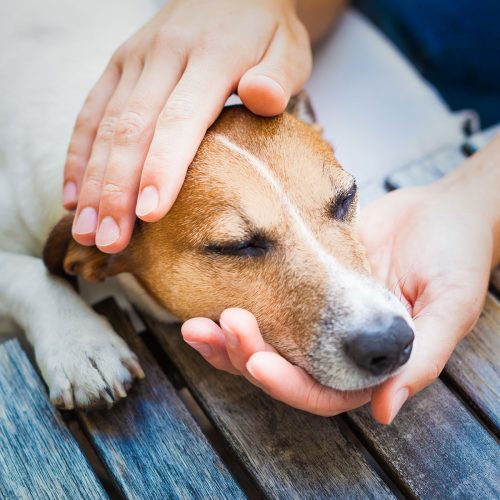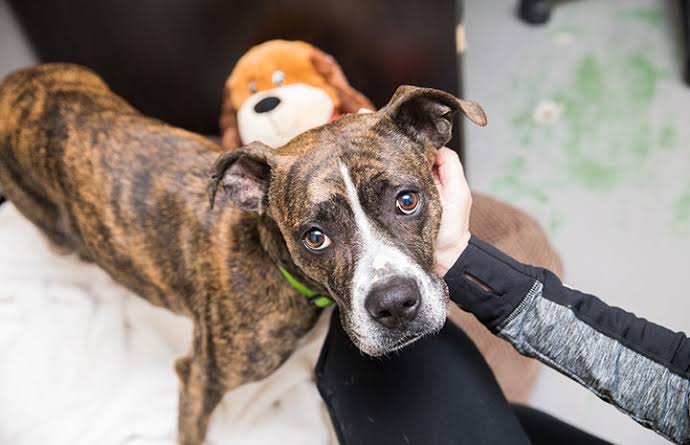If you’ve ever had to soothe a trembling pup during a thunderstorm or coax your dog out from under the bed during fireworks, you’re not alone.
Anxiety in dogs is a common issue, and just like humans, our furry companions can struggle with stress, nervousness, and even panic attacks. Whether it’s separation anxiety, noise phobias, or general nervousness, the good news is—there’s a lot you can do to help.
In this guide, we’re diving into eight calming techniques that have helped thousands of pet parents bring peace and comfort to their anxious dogs. Let’s explore them in a friendly, step-by-step manner so you can figure out what works best for your pup.
1. Create a Safe Space or “Dog Den”
One of the first things you can do is give your dog a sanctuary—a quiet, cozy place they can retreat to when they’re feeling overwhelmed.
How It Helps:
Dogs are den animals by nature. A secure space provides a sense of control and comfort. When anxiety kicks in, having a familiar, calming area can reduce fear dramatically.
How to Set It Up:
- Choose a quiet corner of your home.
- Use a crate with soft bedding, or a covered nook with their favorite toys.
- Add a worn t-shirt that smells like you—this can be very comforting.
- Keep it consistent. Don’t use the area as punishment.
Pro Tip: During fireworks or storms, play soft classical music nearby to muffle scary sounds.
2. Try Calming Pheromone Products
You may not be able to see or smell them, but calming pheromones are a dog’s natural stress-relief scent.
How It Works:
Mother dogs release pheromones to soothe their puppies. Synthetic versions mimic this effect, helping reduce fear and tension.
Popular Options:
- Adaptil plug-ins, sprays, or collars
- Pheromone-infused wipes for crates or bedding
They’re totally safe and non-sedating—great for dogs with general anxiety or travel stress.
3. Use Consistent Daily Exercise
Just like people, dogs need to burn off nervous energy. A tired dog is often a calmer dog.
How It Helps:
Exercise increases serotonin levels in the brain (the “feel-good” chemical) and reduces cortisol (the stress hormone). It’s especially important for high-energy or working breeds like Border Collies or German Shepherds.
What to Do:
- Long walks or hikes
- Fetch in the backyard
- Tug-of-war or agility games
- Swimming, if your dog enjoys water
Tip: Don’t overdo it. Just 30–60 minutes of daily activity can make a world of difference.
4. Offer Calming Supplements
Natural calming chews and supplements are a popular go-to for anxious dogs—and many of them work wonders when used consistently.
What to Look For:
- L-theanine – boosts dopamine and serotonin
- CBD oil (vet-approved) – reduces anxiety without making your dog drowsy
- Melatonin – a gentle sleep aid for stressful events
- Chamomile or valerian root – natural calming herbs
Always check with your vet before starting any supplement. Some ingredients might interact with medications or pre-existing conditions.
5. Practice Desensitization and Counter-Conditioning
This is a more long-term but highly effective approach. Basically, you’re teaching your dog that what scares them isn’t actually a threat.
How It Works:
- Desensitization: Gradually expose your dog to the fear trigger at a low intensity (like a quiet thunder sound).
- Counter-conditioning: Pair the scary thing with something positive—like treats or playtime.
Example:
If your dog is scared of vacuum cleaners, start by leaving the vacuum unplugged in the room while giving treats. Gradually progress to turning it on for a second while rewarding calm behavior.
Bonus: These training techniques build trust between you and your dog and often have lasting results.
6. Try a Compression Vest (Like the Thundershirt)
Think of it as a gentle hug for your dog. These vests apply constant, gentle pressure, which can be incredibly soothing for some pups.
Benefits:
- Helps dogs with storm anxiety, travel stress, or separation issues
- Easy to use and drug-free
- Lightweight and comfortable
How to Use:
- Put it on your dog before anxiety triggers begin (like before you leave the house)
- Watch their behavior—it works best when your dog is still relatively calm
Some dogs respond instantly; for others, it might take a few uses to see full results.
7. Use Calming Sounds or Music Therapy
Believe it or not, dogs are sensitive to music and ambient sounds, and the right kind of noise can help them stay calm.
What Works Best:
- Classical music (studies show it has the most calming effect)
- Specialized dog-calming playlists (available on Spotify or YouTube)
- White noise machines or nature sounds
Why It Helps:
These sounds can mask anxiety-inducing noise like traffic, fireworks, or thunderstorms. Over time, your dog might even associate the music with feelings of safety.
8. Stay Calm Yourself and Use Reassuring Touch
Last but definitely not least: your own energy plays a huge role. Dogs are incredibly intuitive—they sense when you’re stressed or nervous, and they mirror that tension.
What You Can Do:
- Speak in soft, reassuring tones
- Use gentle petting or massage (especially behind the ears and along the spine)
- Practice calm breathing when your dog is anxious—it may help them synchronize their rhythm with yours
Important: Avoid over-comforting. While affection is good, excessive fussing can reinforce the idea that there’s something to be afraid of.
Bonus Tip: Don’t Wait Until It’s “Bad”
Early intervention is key. If you notice small signs of anxiety—like lip licking, pacing, yawning, or hiding—start introducing calming techniques before things escalate.
And if your dog’s anxiety becomes unmanageable or begins affecting their health, it’s absolutely worth seeking help from a veterinarian or certified animal behaviorist.
They can:
- Rule out medical issues
- Prescribe anti-anxiety medications if necessary
- Help create a behavior modification plan tailored to your dog
Final Thoughts: Every Dog Is Different
Just like humans, every dog has their own personality, fears, and comforts. What works wonders for one might not work for another. That’s why it’s so important to try multiple calming techniques and observe your dog’s response.
The journey to a calmer, happier pup might take a little trial and error—but the payoff is huge. Not only will your dog feel better, but you’ll feel more at peace knowing you’ve given them the tools to cope.
So whether it’s soothing music, a snug vest, or a new training routine, you’ve got plenty of ways to support your best friend through their anxious moments.



